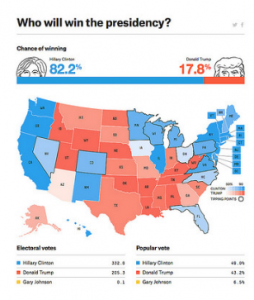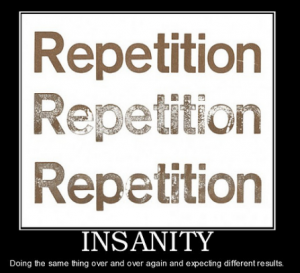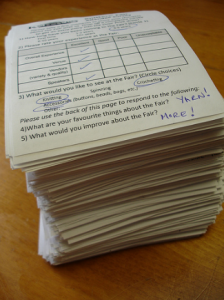There’s anecdote that I’ve heard a few times about a man who goes to a diner for a meal. After finishing his dinner the waitress asks him if he’d like some dessert. When he inquires as to what flavors of pie they have the waitress tells him they have apple and cherry. The man says cherry and the waitress leaves to get it. She returns shortly afterwards and tells him she had forgotten they actually also had a blueberry pie. “In that case,” the man replies, “I’ll have apple.” Breaking this story down into a more abstract form, the man was presented with two options: A and B. Since he prefers A to B, he naturally selected A. However, when represented with A, B, and C, he now appears to reverse his initial preference, favoring B over A. Since he appears to prefer both A and B over C, it seems strange that C would affect his judgment at all, yet here it does. Now that’s just a funny little story, but there does appear some psychological literature suggesting that people’s preferences can be modified in similar ways.
“If only I had some more pointless options to help make my choice clear”
The general phenomenon might not be as strange as it initially sounds for two reasons. First, when choosing between A and B, the two items might be rather difficult to directly compare. Both A and B could have some upsides and downsides, but since they don’t necessarily all fall in the same domains, weighing them against the other isn’t always simple. As a for instance, if you looking to buy a new car, one option might have good gas mileage and great interior features (option A) while the other looks more visually appealing and comes with a lower price tag (option B). Pitting A against B here doesn’t always yield a straightforward choice, but if option C rolls around that gets good gas mileage, looks visually appealing, and comes with a lower price tag, this car can look better than either of the previous options by comparison. This third option need not even better more appealing than both alternatives, however; simply being preferable to one of them is usually enough (Mercier & Sperber, 2011).
Related to this point, people might want to maintain some degree of justifiably in their choices as well. After all, we don’t just make choices in a vacuum; the decisions we make often have wider social ramifications, so making a choice that can be easily justified to others can make them accept your decisions more readily (even if the choice you make is overall worse for you). Sticking with our car example, if you were to select option A, you might be praised by your environmentally-conscience friends while mocked by your friends more concerned with the look of the car; if you choose option B a similar outcome might obtain, but the friends doing the praising and mocking could switch. However, option C might be a crowd pleaser for both groups, yielding a decision with greater approval (you miss out on the interior features you want, but that’s the price you pay for social acceptance). The general logic of this example should extend to a number of different domains both in terms of things you might select and features you might use as the basis to select them on. So long as your decisions need to be justified to others, the individual appeal of certain features can be trumped.
Whether these kinds of comparison effects exist across all domains is an open question, however. The adaptive problems species need to solve often require specific sets of cognitive mechanics, so the mental algorithms that are leveraged to solve problems relating to selecting a car (a rather novel issue at that) might not be the same that help solve other problems. Given that different learning mechanisms appear to underlie seemingly similar problems – like learning the location of food and water - there is some good theoretical reasons to suspect that these kinds of comparison effects might not exist in domains where decisions require less justification, such as selecting a mate. This brings us to the present research today by Tovee et al (2016) who were examining the matter of how attractive people perceive the bodies of others (in this case, women) to be.
“Well, that’s not exactly how the other participants posed, but we can make an exception”
Tovee et al (2016) were interested in finding out whether judging bodies among a large array of other bodies might influence the judgments on any individual body’s attractiveness. The goal here was to find out whether people’s bodies have an attractiveness value independent of the range of bodies they happen to be around, or whether attractiveness judgments are made in relation to immediate circumstances. To put that another way, if you’re a “5-out-of-10″ on your own, might standing next to a three (or several threes) make you look more like a six? This is a matter of clear empirical importance as, when studies of this nature are conducted, it is fairly common for participants to be rating a large number of targets for attractiveness one after the other. If attractiveness judgments are, in some sense, corrupted from previous images there are implications for both past and future research that make use of such methods.
So, to get at the matter, the researchers employed a straightforward strategy: first, they asked one group of 20 participants (10 males and females) to judge 20 images of female bodies for attractiveness (these bodies varied in their BMI and waist-to-hip ratio; all clothing was standardized and all faces blurred out). Following that, a group of 400 participants rated the same images, but this time only rating a single image rather than 20 of them, again providing 10 male and female ratings per picture. The logic of this method is simple: if ratings of attractiveness tend to change contingent on the array of bodies available, then the between-subjects group ratings should be expected to differ in some noticeable way than those of the within-subjects group.
Turning to the results, there was a very strong correspondence between male and female judgments of attractiveness (r = .95) as well as within sex agreement (Cronbach’s alphas of 0.89 and 0.95). People tended to agree that as BMI and WHR increased, the women’s bodies became less attractive (at least within the range of values examined; the results might look different if women with very low BMIs were examined). As it turns out, however, there were no appreciable differences when comparing the within- and between-groups attractiveness ratings. When people were making judgments of just a single picture, they delivered similar judgments to those presented with many bodies. The authors conclude that perceptions of attractiveness appear to be generated by (metaphorically) consulting an internal reference template, rather than such judgments being influenced by the range of available bodies.
Which is not to say that being the best looking member of group will hurt
These findings make quite a bit of sense in light of the job that judgments of physical attractiveness are supposed to accomplish; namely assessing traits like physical health, fertility, strength, and so on. If one is interested in assessing the probable fertility of a given female, that value should not be expected to change as a function of whom she happens to be standing next to. In a simple example, a male copulating with a post-menopausal female should not be expected to achieve anything useful (in the reproductive sense of word), and the fact that she happened to be around women who are even older or less attractive shouldn’t be expected to change that fact. Indeed, on theoretical level we shouldn’t expect the independent attractiveness value of a body to change based on the other bodies around; at least there doesn’t seem to be any obvious adaptive advantages to (incorrectly) perceive a five as a six because she’s around a bunch of threes, rather than just (accurately) perceiving that five as a five and nevertheless concluding she’s the most attractive of the current options. However, if you were to incorrectly perceive that five as a six, it might have some downstream consequences when future options present themselves (such as not pursuing a more attractive alternative because the risk vs. reward calculations are being made with inaccurate information). As usual, acting on accurate information tends to have more benefits that changing your perceptions of the world.
References: Mercier, H. & Sperber, D. (2011). Why do humans reason? Arguments for an argumentative theory. Behavioral and Brain Sciences, 34, 57-111.
Tovee, M., Taylor, J., & Cornelissen, P. (2016). Can we believe judgments of human physical attractiveness? Evolution & Human Behavior, doi: 10.1016/j.evolhumbehav.2016.10.005































